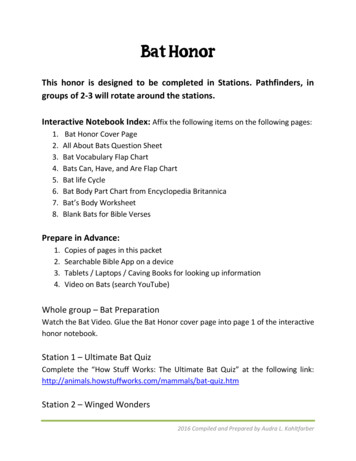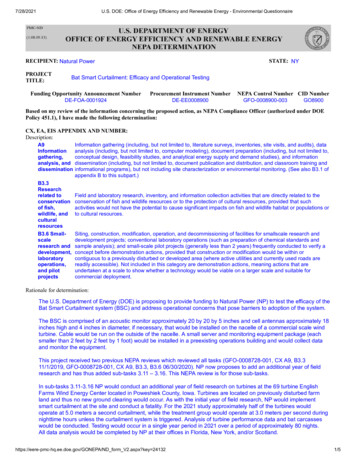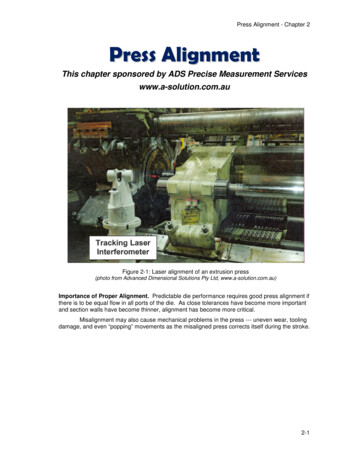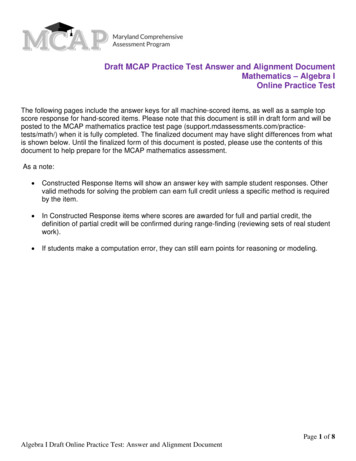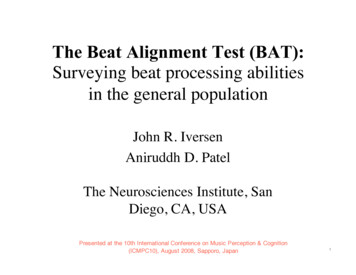
Transcription
The Beat Alignment Test (BAT):Surveying beat processing abilitiesin the general populationJohn R. IversenAniruddh D. PatelThe Neurosciences Institute, SanDiego, CA, USAPresented at the 10th International Conference on Music Perception & Cognition(ICMPC10), August 2008, Sapporo, Japan1
AbstractThe ability to perceive a musical beat (and move in synchrony with it) seems widespread,but we currently lack normative data on the distribution of this ability in musicallyuntrained individuals. To aid in the survey of beat processing abilities in the generalpopulation, as well as to attempt to identify and differentiate impairments in beatprocessing, we have developed a psychophysical test called the Beat Alignment Test(BAT). The BAT is intended to complement existing tests of rhythm processing bydirectly examining beat perception in isolation from beat synchronization. The goals ofthe BAT are 1) to study the distribution of beat-based processing abilities in the normalpopulation and 2) to provide a way to search for “rhythm deaf” individuals, who havetrouble with beat processing in music though they are not tone deaf. The BAT is easilyimplemented and it is our hope that it is widely adopted. Data from a pilot study of 30individuals is presented.21
Introduction How widespread is the ability toperceive (and move to) a musical beat? Goals– Survey beat processing abilities in thepopulation– Identify selective impairments of beatprocessing2
"Rhythm Deafness" Mostly anecdotal evidence Does it exist in a pure form?– i.e. not simply as a consequence of pitchperception impairments3
Simple model of beat processingBeat PerceptionBeat Production4
Perception and Production How tightly coupled is performance onbeat perception and production tasks?– Normal perception with impairedproduction? Cf. dissociations between deficits inpitch perception and production– (Dalla Bella, et al. 2007; Loui, et al. 2008)5
Synchronizing with real music Few studies have investigatedsynchronization with real musicalpassages in musically-untrainedindividuals– E.g. Drake, et al. 2000; Snyder &Krumhansl, 20016
The BAT Test The Beat Alignment Test (BAT)– Easy, naturalistic– Musical excerpts from multiple genres– Complements existing tests– Examines beat perception in isolation fromsynchronization– Freely available7
The BAT Test Subtests1)2)3)4)Synchronization with metronomeSynchronization with musical passagesPerception of beat in musical passagesQuestionnaire8
Synchronization with a beat Spontaneous tapping at preferredtempo Synchronization with metronome– 400, 550, 700 ms IOI Synchronization with music9
Testing perception of musical beat Judge if beeps superimposed onexcerpts are "on the beat" or not.– Perturbations of tempo or phase: On beat Tempo error ( /- 10%) Phase error ( /- 25% of beat period)10
Musical ExcerptsStyleRockRockRockRockJazzJazzJazzJazzPop OrchestralPop OrchestralPop OrchestralPop OrchestralPieceHard to handleOne way or anotherHurts so goodPanama1 o’clock jumpStompin’ at the savoyTuxedo junctionKing Porter stompNY, NYA chorus lineSupermanRichardRogersWaltzesArtistBlack CrowesBlondieJ. MellencampVan HalenBenny GoodmanBenny GoodmanGlenn MillerGlenn MillerBoston PopsBoston PopsBoston PopsBoston PopsAverage duration: 16s11
Synchronization resultsVariation in metrical level of synchronizationFigure 1. Example of all participant's synchronization to one musical excerpt (Richard Rodgers Waltzes).Gray lines indicate the musical beats; Red lines indicate time of each tap. Participant's mean ITI is shown.12
Examples of tempo matchingFigure 2. Examples of synchronization accuracy for two participants. Inter-tapinterval (ITI) is plotted versus the tactus inter-onset interval (IOI) of the musicalexcerpt for all excerpts. Shown are a participant with excellent accuracy (filledcircles) and the participant with the worst tempo accuracy (open squares).13
Overall tempo trackingFigure 3. Synchronization performance across all participants and excerpts.Tapping ITI is plotted versus the tactus IOI of the musical excerpts, as in Figure 2.14
Perception performanceFigure 4. Beat perception performance across all 30 participants for three beat alignmentconditions: on beat, tempo error, and phase error.15
Perception and synchronizationFigure 5. Correlation of tapping tempo and musical excerpt tempo vs. score on theperceptual task. Each point shows the mean across all excerpts for one participant.16
Perception and synchronization 2Figure 6. Variation in tapping (CV of ITIs) vs. score on the perceptual task.17
Summary The BAT test was easily understood by nonmusicians Synchronization– Tempo matching was generally good Perception– Synchronization performance correlated with perceptionscore Future– Larger sample– Include MBEA18
Join us! The BAT is easy to administer andfreely available:– www.nsi.edu/users/iversen/bat/BAT TEST.zip19
References Dalla Bella, S., Giguère, J. F., and Peretz, I. (2007) Singing proficiency in the generalpopulation. J Acoust Soc Am, 121, 1182-9.Dalla Bella, S. and Peretz, I. (2003). Congenital amusia interferes with the ability to synchronizewith music. Ann N Y Acad Sci 999, 166-9.Drake, C., Jones, M. R., and Baruch, C. (2000). The development of rhythmic attending inauditory sequences: attunement, referent period, focal attending. Cognition 77, 251-88.Foxton, J. M., Nandy, R. K., and Griffiths, T. D. (2006). Rhythm deficits in 'tone deafness'. Brainand Cognition 62, 24-9.Loui, P., Guenther, F. H., Mathys, C., and Schlaug, G. (2008). Action–perception mismatch intone-deafness. Current Biology 18, R331-2.Peretz I., Champod, A. S., and Hyde, C. (2003). Varieties of musical disorders. The MontrealBattery of Evaluation of Amusia. Ann N Y Acad Sci 999, 58-75.Repp, B. H. (2005). Sensorimotor synchronization: A review of the tapping literature.Psychonomic Bulletin & Review 12, 969-992.Seashore, C. B., Lewis C., and Saetveit, J. G. (1960). Seashore measure of musical talent.New York, NY: Psychological Corporation.Snyder, J. and Krumhansl, C. L. (2001). Tapping to ragtime: cues to pulse finding, MusicPerception 18, 455 – 489.Thompson, W. F., Sigmundsdottir, L., Iversen, J. R., and Patel, A. D. (2008). Selective rhythmicimpairments in music. 10th International Conference of Music Perception and Cognition,Sapporo, Japan.20
processing, we have developed a psychophysical test called the Beat Alignment Test (BAT). The BAT is intended to complement existing tests of rhythm processing by directly examining beat perception in isolation from beat synchronization. The goals of the BAT are 1) to study the distribution of beat-based processing abilities in the normal


